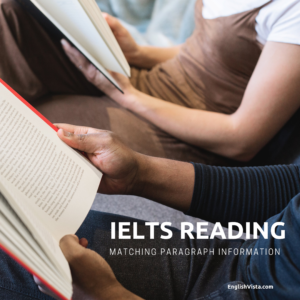
IELTS Reading Test: Matching Paragraph Information
The IELTS Reading Test may contain a question that requires you to identify which paragraph information is found in or match headings to the correct paragraph. For this type of question, you need to understand the main topic of each paragraph and choose the most appropriate answer.
Here are our top tips for ‘Matching Paragraph Information’ questions:
- Read through the whole article to get the ‘gist’ but do not worry about understanding all parts
- Make notes as you skim through the article on any key themes emerging from paragraphs
- After skimming through the whole article, look at the questions
- If any paragraph information matches are immediately obvious, record that answer and remove that option from the list. This helps by reducing the options for the paragraphs you are not so sure about
- When reading the statements you are trying to match, consider how the information could be paraphrased to help you to locate the information
- Once you have matched the questions you are able to do easily, go back to the remaining paragraphs
- Re-skim through the paragraph, think about what is being discussed and consider which paragraph best fits
- Don’t spend too much time on these questions
This task will also give you exposure to a topic that may come up in any of the IELTS tests and will support you to learn and understand new vocabulary. You are also going to be practising your reading skills so this will help you with the tests whether a question like this comes up or not!
Level: Medium
Although this article features more complex vocabulary, the paragraphs are relatively short in length so there is not too much text to be decoded.
Sustainable Agriculture
1. __________________
Farmers prefer corn monoculture because it is a very productive crop, but also a resource intensive crop. Perhaps, this wouldn’t be such a problem if it were used for our consumption, but it is not. 40 percent of corn is used for ethanol production for biofuels, 36 percent is fed to factory farmed livestock and most of the remaining amount is either exported or used in a high-fructose corn syrup production.
2. _________________
For example, researchers observed in the U.S. Corn Belt that the corn yields decrease by almost one third if it rains more in spring. This is not good news for most farmers because the climate change models predict an increase in spring rains in the area.
3. _________________
To make space for conventional farms, ecosystems have to disappear–soils are tilled and straightened; trees are cut down, their roots are ripped from the ground; creeks are redirected into perfectly straight channels along cropland boundaries; wetlands are dried out and native perennial vegetation is buried.
4. ________________
The main objective of this farming system is to achieve the maximum possible yield from land. This requires inputs of synthetic fertilizers and pesticides to artificially create favorable conditions for crops. It has also led to the development of genetically modified varieties that are “programed” to give higher yields.
5. _________________
If conventional agriculture was characterized by efficiency, uniformity and maximization, sustainable agriculture could be described by: diversity, interconnectedness and preservation.
Source of passage: https://greentumble.com/can-sustainable-agriculture-feed-the-world/
1. Match the following paragraph headings with the correct paragraph in the text.
A) What are the main objectives of sustainable agriculture?
B) Food
C) Environment
D) What is the difference between conventional and sustainable agriculture?
E) Climate resilience
2. In which paragraph will I find the following information? Give the paragraph number as your answer. Numbers may be used more than once.
A) Rainfall in March and April is predicted to rise.
B) Some corn that is grown is used as food for farm animals being reared for food production.
C) The space used for farms removes important natural environments.
D) New approaches to agriculture are focused more on preserving the land as it is.
Answers:
Question 1:
A) 4
B) 1
C) 3
D) 5
E) 2
Question 2:
A) 2
B) 1
C) 3
D) 5
